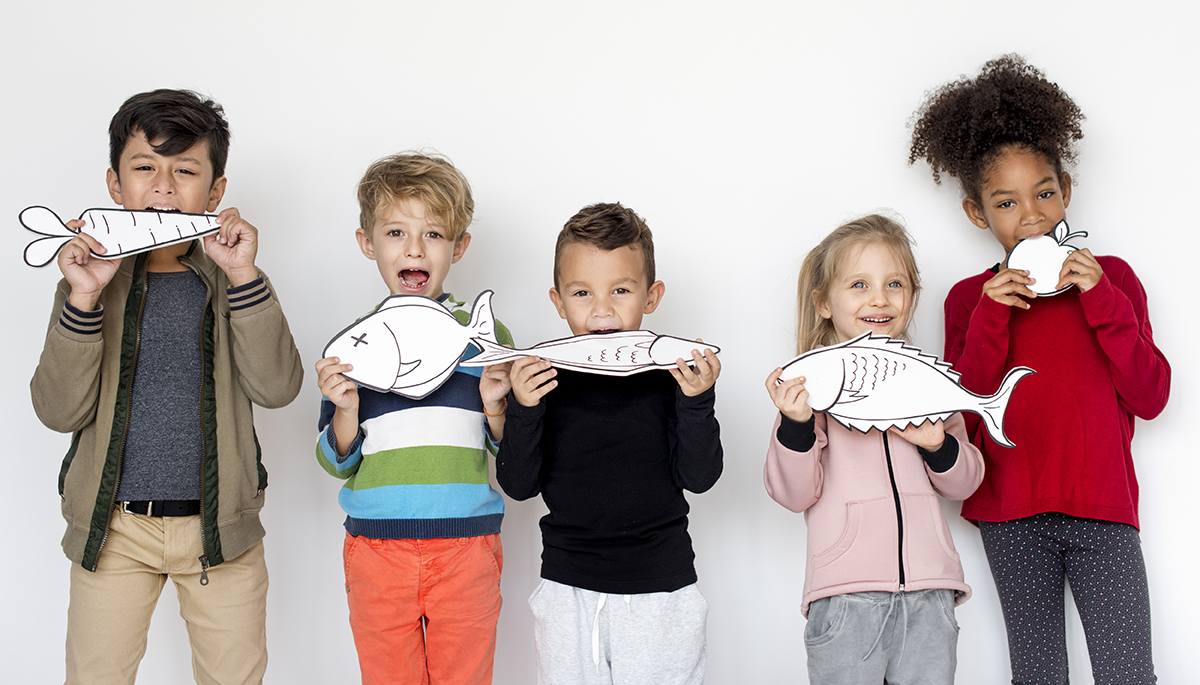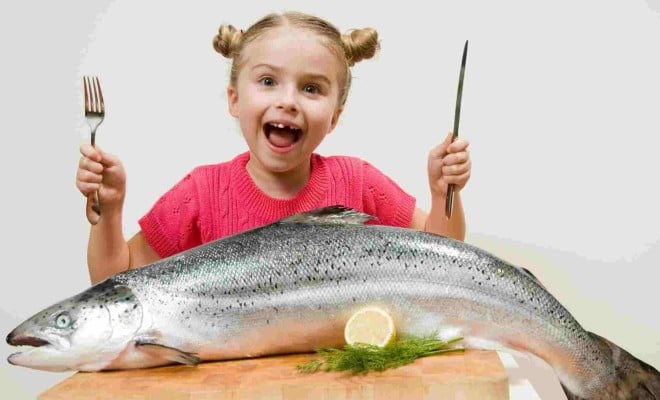Seafood and its Benefits for Children
As difficult as it is for parents to get their children to eat nutritious, healthy meals with the literally thousands of food choices available today—both good and bad, when it comes to seafood, what makes it a healthy food choice for children? More importantly, how do you get children to even like something as strange looking (and sometimes scary looking too!) as seafood? It’s been estimated that as few as 10% of American children eat enough seafood.
The Point of View from Pediatricians
For a food as peculiar to very young children as seafood, according to pediatricians, they recommend an introduction of solid seafood to a child’s diet at about four to six months old. One good and important reason to feed them seafood early on (besides seeing if they’ll like it), is to learn if they’ll have any kind of allergic reactions to seafood, which if discovered early, can help identify other allergies that may be related to foods that could contain elements or byproducts of seafood. There are however, some fish that aren’t suitable for children: shark, marlin, and swordfish. And be careful with canned and fresh tuna, which contain mercury.

Make Eating Seafood a Healthy Habit
When parents start introducing seafood to their children’s diets, they help them create good eating habits that will last a lifetime. Dietary Guidelines say that at least two servings of seafood weekly, in proportions that are suitable for their ages, is a good way to line up seafood intake with their caloric needs.
You can start off simply with foods that are easy to make. Try whipping up a bowl of tuna salad and use it as a dip with whole-grain crackers as an easy introduction to seafood that can be eaten as a tasty after-school snack! From there, you can always work your way up the seafood chart to more varied and interesting seafood varieties.
“Go Fish” with a few Mealtime Ideas!
Sometimes parents have to change the way they look at mealtimes themselves to have an impact on their children’s eating habits. One way to do that is to make mealtime something you’re looking forward to with great anticipation. Show them that you can’t wait for them to try something that’s going to be delicious and wonderful, and something that they’re sure to love. A little persuasive reasoning goes a long way! Try not to wait for them to get it on the plate in front of them and then ask that kiss-of-death question “...don’t you like that?”
Show them that you eat just like they do, by making the same meal for lunch and dinner for everyone to enjoy. When children can see you eating the same foods as them, they’re more likely to be open to trying new things.
Spice things up a bit with seasonings and new flavors to help your children develop their palate and develop their own sense of taste. Try working in new flavors to familiar foods, like black olives to tuna salad, or a sprinkling of seasoning to a piece of fish to allow their taste buds to develop.

Fish is a child’s Best Friend
Food experts all agree that eating fish is beneficial, especially for children of every age. It’s a source of food that’s rich in the nutrients young bodies need to grow and help prevent many diseases that affect people later in life.
The protein in fish and seafood alone helps young bodies in every way and in every part—from skin, hair, and nails, to the heart and lungs, plus muscles. Protein is a vital nutrient that’s needed for the healthy development the body. If children can consume a food rich in protein at lunch and dinner, that’s a healthy choice, and fish is one of the best. At an age when children and teens are growing rapidly, protein is the protective shield that helps children’s bodies produce the antibodies that are essential to help fight infections.
Protein-rich fish and seafood also contains several vitamins and minerals that are essential to our health. Selenium, iodine, and zinc are all essential components that we need to maintain good health, and fish is one of the prime sources of these.
- Selenium
is a protective antioxidant that helps to shield the body from toxins, and may have a part in helping to prevent cancer.
- Iodine
is needed by the body to help maintain a properly functioning metabolism.
- Zinc
provides increased support to immune systems to help combat the onset of colds and their accompanying symptoms.
Oil-rich fish is also a good source of vitamin A, which helps maintain healthy skin and eyes, and vitamin D, which is essential to maintain healthy bones and teeth. It’s also known to have medical benefits that help protect the body from debilitating conditions such as cancer, type 1 diabetes, and multiple sclerosis. And all fish are rich in B vitamins which help process the releasing of energy that comes from the food. B12 is also contained in fish, which helps young bodies grow new blood cells.
We adults have all heard a lot of information on how important omega-3 fatty acids are, and how important they can be for the health of our heart. Since these fats can’t be made by the body, we need to get them from the food we consume, and a good source of that is through fish.
Children need omega-3 fats to help their brains and nerves develop. Omega-3 fats count for about as much as 60% of the makeup of the brain. While growing in the mother’s womb, the baby receives omega-3 from the foods the mother eats as well as from breast milk or formula milk after birth. So the farther away they get from the milk, the less contact they have with omega-3. That’s why consuming fish and seafood is important to children. By getting them to enjoy eating fish and seafood more and building it into their diets regularly, healthy growth and development plus protection against some of the diseases that afflict adults can be achieved.
Tough sell on Fish?
Some–no many, children are reluctant to step out of their food comfort zones and embrace, what to them is, a strange new taste and texture of food. Even though it’s incredibly healthy, that won’t matter to them. They’ll need some persuading!
Between the ages of 2 and 3, you’re most likely to get a lot of pushback from kids to eat something that’s known to be healthy and good for them. That’s okay. It doesn’t strike out fish and seafood from their lives forever. After all, there are parents who don’t like fish and seafood! But with fish becoming almost a daily presence in our lives, it’s important to give young children time and room to develop their seafood tastes. It just may take a few tries before they embrace the new food.
What to Do...
Try to continue offering fish even just once a week. While it may take for children to adapt and accept a new taste and texture with their food, as they become more familiar and comfortable with eating it. Just be patient. Give them small amounts and slowly work your way up. In about 6 weeks, they may finally change their attitude! Encourage them to try just a small bite each time you have fish, and to eat more if they like it.
Serve them a milder flavored fish, like whiting or haddock, but make sure it has no bones! Little by little, they’ll hopefully learn to like the taste of the fish they’re trying, at which point it might be easier to start slowly rolling in new varieties.
Don’t make them eat it forcefully. That could be a big turnoff to them. What you can do is eat fish right in front of them yourself. Because children often copy doing what they’re parents do, they may be more likely to try it if they see you try it!
Offer them a sample of fish at the earliest you think they can handle it. Fish and seafood make for perfect weaning foods, but make sure they don’t have any obstructions in the way, such as bones.
Let your older children get involved in cooking and preparing dinner meals with fish. Usually, if they do it themselves, they’re more prone to trying out their own cooking!
Mix it up as they get used to different kinds of fish and seafood. Try serving cod, haddock, salmon, trout, along with fresh fish and canned fish. Cook it different ways: steamed, baked, even deep fried is okay once in a while.
Once they’re Hooked
There are many, many outstanding reasons why fish and seafood is beneficial for children to eat than just the outstanding health reasons. Gaining a greater sense of where our food comes from and the importance of sustaining our food resources are other important reasons. Sharing the joys of cooking and tasting new and exotic recipes is a wonderful benefit that seafood has over so many other foods. Exploring the world of seafood is a never ending journey of taste and excitement!